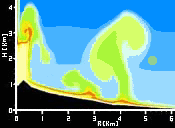
PD Dr. Ulrich Knittel:
Vulkanismus.de
Buchbesprechung
| zurück zur Startseite |
| Virtuelle Vorlesung zum Thema Vulkanismus |
| Entstehung von Magma |
| Mount Saint Helens |
| Homepage Taal (Philippinen) |
| Steffeln-Kopf (Westeifel) |
| Buchbesprechungen |
| |

von Davis A. Young
60,29 US $ bei amazon.com
ISBN 0-8018-5614-0
Das Buch bestellen!
- german review -
The science of igneous petrology at present is dominated by scientists from AngloSsaxon countries. For example, to my knowledge, there is no modern German language textbook on this topic, while excellent English-language texts appear almost every year. But there was a time, when this was different, wasn't it?
The book under review here provides the answer. On more than 600 pages the author traces the history of the study of igneous rocks. In so doing, he does not trace the chronology of events but pursues the development of certain ideas or evaluates the impact of new techniques. Thus, there are chapters on 'The Microscope Era', 'The Experimental Era' or 'The Geochemical Era'.
The chapters dealing with recent developments present a more personal view of the author. This is inevitable, because only time will show, which developments and papers will be the milestones of future insights. Hence, some readers will miss papers that they themselves consider as landmarks or future classical paper. Nevertheless, it is this attempt to trace the history up to the present that makes this book so interesting!.
Repeatedly Young devotes a chapter to classical problems of igneous petrology. That of nomenclature and that of the enigmatic emplacement of huge plutons and batholiths. The reader leans that wrestling with nomenclature has been one of the preoccupations of igneous petrologists right from the onset of its establishment as a science! And the unsolved problem of how huge plutons are emplaced has been one of the major obstacles for the acceptance of the igneous origin of granitic rocks, as the reader will learn.
It is remarkable that an American author has undertaken the effort to write the history of igneous petrology in view of the fact, that he has to grabble with the multitude of languages used in early publications on this subject. If nothing else, the author is to be congratulated for mastering this problem.
German readers will miss in the discussion of the controversy between neptunist and plutonists the contributions of J.W. von Goethe, but it must be kept in mind that the scientific community never accepted him as scientist. In the chapters on the granite controversy, he will miss references to the experimental works of G.F. Winkler in Göttingen, who - at least in Europe - did much to convince the geoscience community that granite originates by melting of sediments. This is also true for K. Mehnert, who's book 'Migmatites and the origin of granitic rocks' was presented to the author of this review in his student days as the 'final solution to the granite controversy'.
The value of this book lies in part in the fact, that the author succeeds to show, that many controversies, the solution of which appear very evident from our current point of knowledge, were rooted in the then available understanding of igneous petrology, i.e. even the proponents of ideas that were finally shown to be false, had good arguments. This might be a warning that future generations likewise may only smile at our most sophisticated ideas.-
With Christmas soon approaching and view of the current exchange ratio of the US dollar I can only recommend: buy now!
Dr. Ulrich Knittel